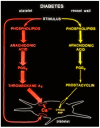Inflammation: Is It a Healer, Confounder, or a Promoter of Cardiometabolic Risks?
- PMID: 39199336
- PMCID: PMC11352362
- DOI: 10.3390/biom14080948
Inflammation: Is It a Healer, Confounder, or a Promoter of Cardiometabolic Risks?
Abstract
Inflammation is the body's non-specific response to injury or infection. It is a natural defense mechanism that helps to maintain homeostasis and promotes tissue repair. However, excessive inflammation can lead to cellular, tissue, or organ dysfunction, as well as contribute to the development of acute vascular events and diseases like Crohn's disease, psoriasis, obesity, diabetes, and cancer. The initial response to injury involves the activation of platelets and coagulation mechanisms to stop bleeding. This is followed by the recruitment of immune cells and the release of cytokines to promote tissue repair. Over time, the injured tissue undergoes remodeling and returns to its pre-injury state. Inflammation is characterized by the activation of inflammatory signaling pathways involving cytokines, chemokines, and growth factors. Mast cells play a role in initiating inflammatory responses. Pattern recognition receptors (PRRs) such as Toll-like receptors (TLRs) and nucleotide-binding domain (NOD)-like receptors (NLRs) are involved in the activation of these inflammatory pathways. Inflammasomes, which are cytoplasmic complexes, also contribute to inflammation by activating cytokines. Inflammation can also be triggered by factors like dietary components and the composition of the gut microbiota. Dysregulation of the gut microbiome can lead to excessive inflammation and contribute to diseases like atherosclerosis and irritable bowel syndrome (IBS). The immune system and gut-associated lymphoid tissue (GALT) play crucial roles in the inflammatory response and the development of conditions like colorectal cancer. Anti-inflammatory therapy can play a significant role in reducing or inducing the remission of inflammatory diseases such as Crohn's disease and ulcerative colitis. The fetal origin of adult diseases theory suggests that conditions during fetal development, such as low birth weight and maternal obesity, can influence the risk of cardiometabolic diseases later in life. All of the known risk factors associated with cardiometabolic diseases such as hypertension, excess weight, obesity, type-2 diabetes, and vascular diseases are accompanied by chronic low-grade inflammation. Inflammation seems to have a role in precipitating even acute vascular events such as heart attacks and stroke. Common markers of inflammation associated with cardiometabolic disease include interleukin (IL)-1β, IL-6, tumor necrosis factor (TNF-α), C-reactive protein (CRP), and soluble TNF receptors such as sTNFR1 and sTNFR2. These markers serve as indicators of systemic inflammation. However, these markers are not disease-specific but provide an insight into the overall chronic inflammatory status. In fact, inflammation has been identified as a potential target for future treatments to reduce or reverse the risk of atherosclerosis-related complications. The regulation of inflammation is complex, and further research is needed to better understand its mechanisms and develop strategies for managing inflammatory disorders. In summary, inflammation is a natural response to injury or infection, but excessive or prolonged inflammation can lead to the progression of various diseases. Understanding the underlying mechanisms of inflammation is important for developing treatments and preventive measures for inflammatory disorders.
Keywords: diabetes; hypertension; inflammation; obesity; vascular disease.
Conflict of interest statement
The authors declare no conflict of interest.
Figures







References
Publication types
MeSH terms
Substances
LinkOut - more resources
Full Text Sources
Research Materials
Miscellaneous

